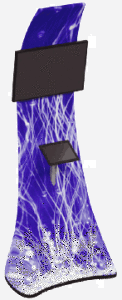Trade Show Booth Design Ideas to Help Reduce Stress
It seems like most business blogs these days tend to spend a lot of time telling you what to do. (And we’re sometimes guilty here as well.) Everything is a high-priority item that you need to give attention to. It creates a gigantic stack of things to worry over that you may not have the time or resources to deal with.
Blogs are great sources for practical advice, but at the end of the day, there are elements of your trade show booth ideas and displays that are less important than other parts. Most of us don’t have the resources to optimize everything, after all.
So, let’s take ‘er easy today and help you prioritize some trade show booth ideas and identify the ones that can be put on the back burner, if you don’t have the time or energy to deal with them.
Six Things You Don’t Need To Stress Over At Your Trade Show Appearances
Sure, if you’ve got the time, money, energy, and enthusiasm, these are all things that could be optimized or improved to squeeze a little more juice out of your booth design. Generally speaking, however, these elements are less important than many of the other decisions you’ll be making.
I. Booth Placement
Aside from wanting to grab an endcap if possible, there’s just not much mileage in trying to find the perfect spot on the floor for your convention display. One spot is usually going to be about as good as another. While it’s possible to do traffic breakdowns and run predictive studies, that’s far more effort than all but the biggest businesses are going to undertake.
Picking the right size for your expo display is a much more important decision. Once you’ve got that, don’t worry so much about the spot as long as it fits your size requirements.
II. Optimized Internal Layouts
Like with booth placement, internal trade show booth layouts are something that detail-oriented people can obsess over for hours. Or days. However, as long as there’s room for people to walk and for all your wares, there’s not going to be too much difference in where you place your various podiums, iPad kiosks, tables, and other trade show furniture.
Besides, the reality is that, much of the time, externalities will force you to change your layout once you actually get to the trade show floor. As a general rule, it’s not worth thinking too hard about booth design elements that are likely to change once your plans meet reality.
About the only exception to this would be expo booths which have specific entry and exit points. At that point crafting the internal experience becomes the focus. Such booths are generally few and far between, although impressive when someone pulls it off.
III. Color-Coordination
It’s great to have a stylish booth, and it does make for nicer photographs. Thinking back, though, how many expo booths can you remember specifically for having a great sense of style?
Unless you’re in a design-related industry, there probably aren’t many that come to mind.
If you’ve got your basic corporate colors represented, and employees in matching shirts, you’re as stylish as you really need to be. If you can keep up with the current season’s colors and work them into your booth design, that’s great, but keeping it simple is fine too.
IV. Local Promotion
Most people these days learn about nearby trade shows through friends or electronic sources. In most cases, running local promotions are only going to attract a small amount of extra traffic. It seems people just don’t randomly go wandering around trade shows too often.
Local promotion really only makes sense when you’re specifically targeting business in that city, with offers that appeal to them specifically as well. Without something really substantial to offer locals, you’re unlikely to get too many new leads who weren’t previously going to attend.
Otherwise, spend your promotional time on electronic sources and on targeted personal marketing rather than on broader campaigns.
V. Sourcing New Promotional Items
Don’t feel like you need to bring new promotional goodies to every trade show. If you show up with the same freebies from last time, no one’s going to notice. In fact, it’s a good money-saving tip to occasionally just bring boxes of your old promotional items to your expo booth as a sort of freebie clearance.
In terms of giveaways, your business card is actually the one you might want to focus on revising. Your card is likely to be more closely looked-at than virtually any other promotional materials. Newer elements like QR Codes, or including your social media contact information, give your leads new ways to contact you as well.
VI. Over-Rehearsing
We absolutely advise rehearsing your staff and having some mock conversations to practice your banter and elevator pitches. Keep in mind that there is such a thing as over-rehearsal in virtually any sort of performance, even if it’s just a sales pitch.
There are two risks here. First, that your staff can get burned out, or tired of talking about your products before the show even starts. Second, over-rehearsing can lead salespeople to seem stiff and unnatural, more like they’re reciting a script. That’s a big turn-off for buyers.
So, keep your practice schedule reasonable. It saves time for other ventures, and usually brings better results as well!
Good Prioritization Leads To Superior Trade Show Displays
Putting together a great expo appearance involves juggling dozens of elements. Anything you can do to lighten your workload is ultimately going to mean improvements in other areas.
When you’re looking at lists of trade show booth ideas and things you “have” to do, take a step back every now and then. When you look at the bigger picture, it’s easier to see which elements most deserve your time and attention when planning your booth designs.
Here’s a related post If you’re looking for more booth design tips.

